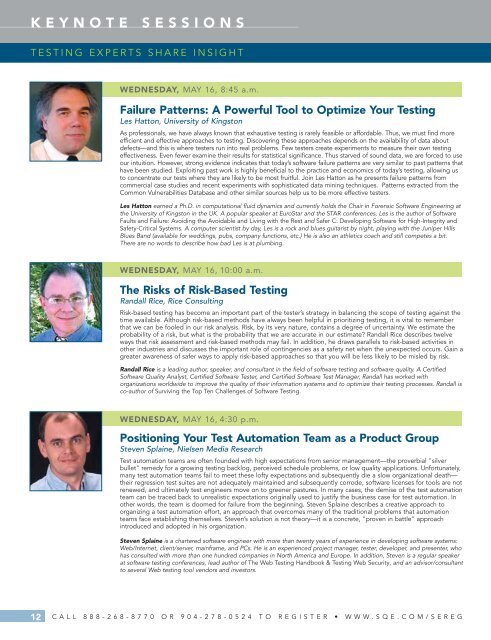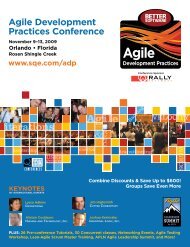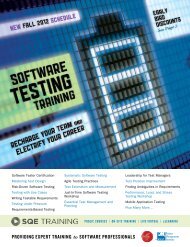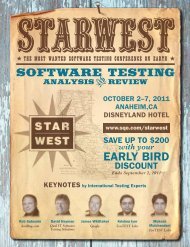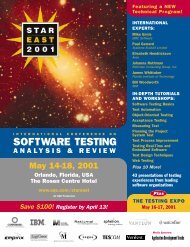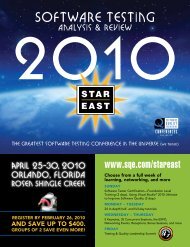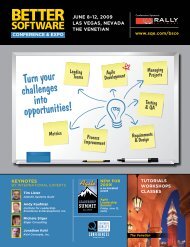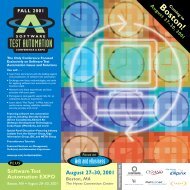KEYNOTE SESSIONS<strong>TESTING</strong> EXPERTS SHARE INSIGHTWEDNESDAY, MAY 16, 8:45 a.m.Failure Patterns: A Powerful Tool to Optimize Your TestingLes Hatton, University of KingstonAs professionals, we have always known that exhaustive testing is rarely feasible or affordable. Thus, we must find moreefficient and effective approaches to testing. Discovering these approaches depends on the availability of data aboutdefects—and this is where testers run into real problems. Few testers create experiments to measure their own testingeffectiveness. Even fewer examine their results for statistical significance. Thus starved of sound data, we are forced to useour intuition. However, strong evidence indicates that today’s software failure patterns are very similar to past patterns thathave been studied. Exploiting past work is highly beneficial to the practice and economics of today’s testing, allowing usto concentrate our tests where they are likely to be most fruitful. Join Les Hatton as he presents failure patterns from<strong>com</strong>mercial case studies and recent experiments with sophisticated data mining techniques. Patterns extracted from theCommon Vulnerabilities Database and other similar sources help us to be more effective testers.Les Hatton earned a Ph.D. in <strong>com</strong>putational fluid dynamics and currently holds the Chair in Forensic Software Engineering atthe University of Kingston in the UK. A popular speaker at EuroStar and the STAR conferences, Les is the author of SoftwareFaults and Failure: Avoiding the Avoidable and Living with the Rest and Safer C: Developing Software for High-Integrity andSafety-Critical Systems. A <strong>com</strong>puter scientist by day, Les is a rock and blues guitarist by night, playing with the Juniper HillsBlues Band (available for weddings, pubs, <strong>com</strong>pany functions, etc.) He is also an athletics coach and still <strong>com</strong>petes a bit.There are no words to describe how bad Les is at plumbing.WEDNESDAY, MAY 16, 10:00 a.m.The Risks of Risk-Based TestingRandall Rice, Rice ConsultingRisk-based testing has be<strong>com</strong>e an important part of the tester’s strategy in balancing the scope of testing against thetime available. Although risk-based methods have always been helpful in prioritizing testing, it is vital to rememberthat we can be fooled in our risk analysis. Risk, by its very nature, contains a degree of uncertainty. We estimate theprobability of a risk, but what is the probability that we are accurate in our estimate? Randall Rice describes twelveways that risk assessment and risk-based methods may fail. In addition, he draws parallels to risk-based activities inother industries and discusses the important role of contingencies as a safety net when the unexpected occurs. Gain agreater awareness of safer ways to apply risk-based approaches so that you will be less likely to be misled by risk.Randall Rice is a leading author, speaker, and consultant in the field of software testing and software quality. A CertifiedSoftware Quality Analyst, Certified Software Tester, and Certified Software Test Manager, Randall has worked withorganizations worldwide to improve the quality of their information systems and to optimize their testing processes. Randall isco-author of Surviving the Top Ten Challenges of Software Testing.WEDNESDAY, MAY 16, 4:30 p.m.Positioning Your Test Automation Team as a Product GroupSteven Splaine, Nielsen Media ResearchTest automation teams are often founded with high expectations from senior management—the proverbial "silverbullet" remedy for a growing testing backlog, perceived schedule problems, or low quality applications. Unfortunately,many test automation teams fail to meet these lofty expectations and subsequently die a slow organizational death—their regression test suites are not adequately maintained and subsequently corrode, software licenses for tools are notrenewed, and ultimately test engineers move on to greener pastures. In many cases, the demise of the test automationteam can be traced back to unrealistic expectations originally used to justify the business case for test automation. Inother words, the team is doomed for failure from the beginning. Steven Splaine describes a creative approach toorganizing a test automation effort, an approach that over<strong>com</strong>es many of the traditional problems that automationteams face establishing themselves. Steven’s solution is not theory—it is a concrete, "proven in battle" approachintroduced and adopted in his organization.Steven Splaine is a chartered software engineer with more than twenty years of experience in developing software systems:Web/Internet, client/server, mainframe, and PCs. He is an experienced project manager, tester, developer, and presenter, whohas consulted with more than one hundred <strong>com</strong>panies in North America and Europe. In addition, Steven is a regular speakerat software testing conferences, lead author of The Web Testing Handbook & Testing Web Security, and an advisor/consultantto several Web testing tool vendors and investors.12 CALL 888-268-8770 OR 904-278-0524 TO REGISTER • WWW.<strong>SQE</strong>.COM/SEREG
KEYNOTE SESSIONSMONDAY, MAY 16, 8:30-5:00<strong>TESTING</strong> EXPERTS SHARE INSIGHTTHURSDAY, MAY 17, 8:30 a.m.Test Estimation: A Pain or . . . Painless?Lloyd Roden, Grove ConsultantsAs an experienced test manager, Lloyd Roden believes that test estimation is one of the most challenging andmisunderstood aspects of test management. In estimation, we must deal with destabilizing dependencies such as poorquality code received by testers, unavailability of promised resources, and “missing” subject matter experts. Often testmanagers do not estimate test efforts realistically because they feel pressure—both external from other stakeholdersand internal from their own desire to be “team” players—to stay on schedule. Lloyd presents seven powerful ways toimprove your test estimation effort and really help the team succeed with honest, data-driven estimating methods.Some are quick and easy but prone to abuse; others are more detailed and <strong>com</strong>plex and perhaps more accurate. Lloyddiscusses FIA (Finger in the Air), Formula or Percentage, Historical, Parkinson’s Law vs. Pricing-to-Win estimates, WorkBreakdown Structures, Estimation Models, and Assessment Estimation. Come discover how to make the painfulexperience of test estimation (almost) painless.With more than twenty-five years in the software industry, Lloyd Roden has worked as a developer, managed an independenttest group within a software house, and joined Grove Consultants in 1999. Lloyd has been a speaker at STAREAST, STARWEST,EuroSTAR, AsiaSTAR, Software Test Automation, Test Congress, and Uni<strong>com</strong> conferences as well as Special Interest Groups inSoftware Testing in several countries. He was Program Chair for both the tenth and eleventh EuroSTAR conferences.THURSDAY, MAY 17, 4:15 p.m.Building the Test Management OfficeGeoff Horne, iSQAIt’s the life challenge of a test manager—leading testing while keeping the work under control. If it’s not poor code, it’sconfiguration glitches. If it’s not defect management problems, it’s exploding change requests. When the projects are large,<strong>com</strong>plex, and constrained, it can be almost impossible to keep ahead of the “gotchas” while ensuring testing progress. ITprojects have long used the concept of a Project Management Office (PMO), providing administrative services to allowProject Managers to focus on their key responsibilities. In the same way, a Test Management Office (TMO) can help testmanagers focus on their key testing activities. Join Geoff Horne as he describes the functions en<strong>com</strong>passed by the TMO;how establishing a TMO can benefit your organization; the management structure and resources needed for success; andhow to prevent the TMO from be<strong>com</strong>ing a dumping ground for issues and people no one else wants to handle.Based in New Zealand, Geoff Horne has more than twenty-eight years of experience in IT including software development,sales and marketing, and IT and project management. In the IT industry he has founded and run two testing <strong>com</strong>panies thathave brought a full range of testing consultancy services to an international clientele. Recently, in the capacity of a programtest manager, Geoff has focused on a few select clients running <strong>com</strong>plex test projects. Geoff has written a variety of whitepapers on the subject of software testing and has been a regular speaker at the STAR testing conferences.FRIDAY, MAY 18, 8:30 a.m.Social Engineering: Testing the Organization as Well as the CodeMike Andrews, FoundstoneWe're all familiar with network security—protecting the perimeter of your <strong>com</strong>pany with firewalls and intrusion detectionsystems. Similarly, we're doing something about application security—hardening from attacks the software on which<strong>com</strong>panies rely. However, what about the "soft" assets of a <strong>com</strong>pany? (And we’re not talking about the sofas and pottedplants dotted around the office.) How prone to attack are the people who work for your <strong>com</strong>pany? Mike Andrews departsfrom the traditional talk of testing software to discuss testing human beings. Will people give up their passwords for acandy bar? How often do people actually check the site to which they are connecting? What tricks are in the arsenal of wilyand unethical social engineers as they attempt to obtain information and con their way into the often unsecured innersanctum of a <strong>com</strong>pany’s network and application software? You’ll be amazed, you’ll be surprised, and you’ll be shocked.You’ll be shaking your head at the stupidity of some people—and you may discover it could easily have happened to you.Technology isn't always to blame—people often are the weakest link.Mike Andrews is a senior consultant at Foundstone where he specializes in software security, leads Web applicationsecurity assessments, and teaches Ultimate Web Hacking classes. He brings a wealth of <strong>com</strong>mercial and educationalexperience from both sides of the Atlantic and is a widely published author and frequent speaker. His book How to BreakWeb Software (co-authored with James Whittaker, Addison Wesley 2006) is currently one of the most popular books onWeb-based application security.CALL 888-268-8770 OR 904-278-0524 TO REGISTER • WWW.<strong>SQE</strong>.COM/SEREG 13
- Page 1 and 2: SOFTWARE TESTING ANALYSIS & REVIEWO
- Page 3 and 4: THE TESTING EXPOMay 16-17, 2007Visi
- Page 5 and 6: AT-A-GLANCE8:30Test Estimation: A P
- Page 7 and 8: SPECIAL EVENTSAttend a Special Even
- Page 9 and 10: PRECONFERENCE TUTORIALSMONDAY, MAY
- Page 11: PRECONFERENCE TUTORIALSTUESDAY, MAY
- Page 15 and 16: CONCURRENT SESSIONSMONDAY, MAY 16,
- Page 17 and 18: CONCURRENT SESSIONSMONDAY, MAY 16,
- Page 19 and 20: CONCURRENT SESSIONSMONDAY, MAY 16,
- Page 21 and 22: CONCURRENT SESSIONSMONDAY, MAY 16,
- Page 23 and 24: STAREAST 2007 REGISTRATION INFORMAT


